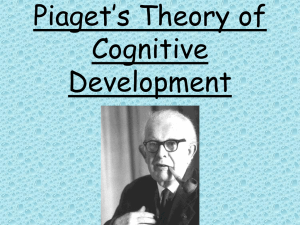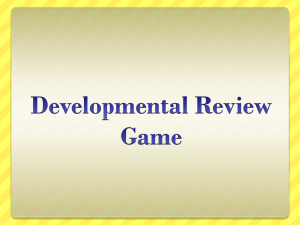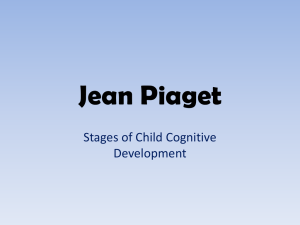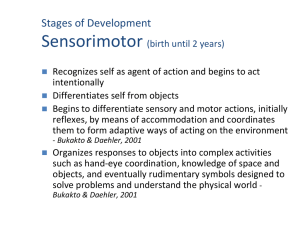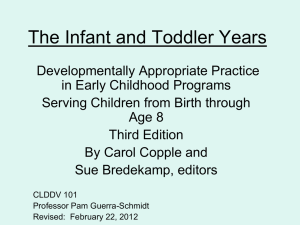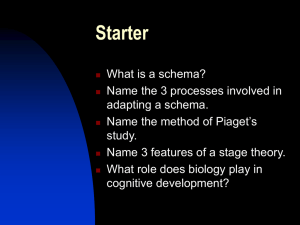Health, Nutrition and Feeding
advertisement
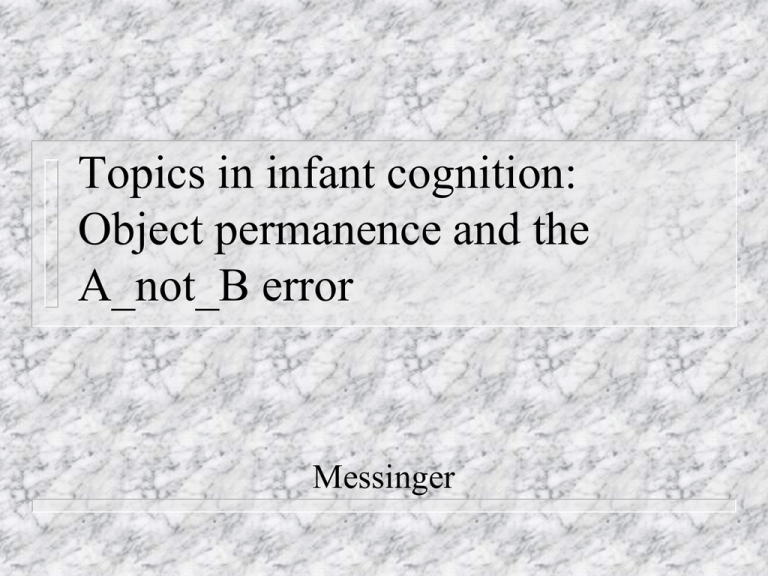
Topics in infant cognition: Object permanence and the A_not_B error Messinger *What is cognition? Cognition refers to mental abilities (thinking, memory, problem-solving, categorization, reasoning, language development, etc.) Four major approaches to understanding cognition in infancy: – – – – Piagetian approach (sensorimotor stage) Nativist approach Information processing approach Psychometric approach Bell 2 Fundamental question: What do infants know? Infants have innate knowledge of essential properties of world – Nativist account: the mind produces ideas that are not derived from external sources Infants have an innate conception of what objects are Infants must construct knowledge of essential properties of world – Constructivist account or empiricist account: experience, especially of the senses, is the only source of knowledge. 5 3 examples Preference for faces Infant counting Object permanence 6 Preference for Faces? Innate or constructed? Fantz, 1961 original study of face preference. – Wilcox, 1969: better “equated” stimuli produced face preference by 4-5 months. Debate continues – – Demonstrated preference, but confounding explanations moving face picture, has shown preference for human face in newborns (Maurer & Young, 1983). Turati vs. Simion? • http://www.cogs.susx.ac.uk/users/alisonp/dev1/lecture2.htm l 7 Can infants count? “Humans innately possess the capacity to perform simple arithmetical calculations......... Infants possess true numerical concepts: they have access to the ordering of numerical relationships between small numbers. They can calculate the results of simple arithmetical operations of small numbers of items” Wynn (1992). • Next 3 slides from Tony J. Simon “Explaining Apparent Infant Numerical Competence in Terms of Object Representation” Initial transf ormation The Task Test trial outcomes Possible Arithmetically Impossible ( Wynn) (+) More looking to impossible results 13 Looking time 12 1+1=1 11 2-1=2 10 9 8 1+1=2 2-1=1 7 6 1 object 2 objects Simon et al. (1995) Number of Objects Remaining Replication of Wynn (1992) Piaget and object constancy What are assimilation and accomodation? How does Piaget believe that infants develop cognitively? – Provide examples from video What does Piaget think about the development of object constancy and the A-not-B error? What do Baillargeon's experiments say about object constancy? What might account for differences increased attention to violations of expectations regarding invisible objects but their deficits in reaching for those objects? – Provide examples from video – Do you think infants can count? How is mental functioning assessed in infancy? 11 Class Piaget’s theory of infant cognitive development – – Habituation paradigms – Object constancy and the a_not_b error A not B videos, NIH floor babies Early evidence for object constancy Resolution 12 Piaget with child Piaget overview: http://www.yo utube.com/wa tch?v=4kscU0 kTNbw 13 Piaget’s History Swiss, 1896 - 1980 First published scientific paper at age 10 Doctorate in biology at age 22 Most influential developmental psychologist ever? • "Piaget, Jean," Microsoft® Encarta® Online Encyclopedia 2000. http://encarta.msn.com © 14 Piaget’s insights Children don't think like grownups. Children are not empty vessels to be filled with knowledge – as traditional pedagogical theory had it They are active builders of knowledge – little scientists who are constantly creating and testing their own theories of the world. • http://www.time.com/time/time100/scientist/profile/piaget.html 15 Piaget Overview The development of knowledge takes place as a result of an individual’s interaction with his or her environment. Children themselves drive cognitive development by actively manipulating and exploring their environment. 16 *Piagetian Approach Four broad themes: – – – – Object Space Time Causality Principal goal to explain objectification – – The knowledge of the self and external objects as distinct and separate entities, persisting across time and space, and following causal rules Major cognitive achievement during first 2 years 19 Piaget’s concepts stage theory, schema, organization, adaptation, – assimilation, accommodation, equilibrium, disequilibrium 20 Schema Unobservable mental systems underlying intelligent behavior. Schema change over development. Initially, schema are action-based motor patterns – After infancy, they move to a mental level. 21 Adaptation Assimilation: – Events in the external world are incorporated into existing schema. An infant who sucks on a bottle can adjust to a pacifier with slight modifications. Peg goes into pre-existing hole Accommodation: – Schema are adjusted or created to produce a better fit with events. An infant who sucks on a bottle and pacifier must accommodate in order to learn to drink from a cup. Make or find a new whole 23 Equilibrium Equilibrium – schema working fine – – – A steady, comfortable cognitive stage. Assimilation prevails. Infants are able to incorporate environmental experiences into their existing schema. 24 Disequilibrium Disequilibrium – schema don’t work, failure – Children are unable to incorporate environmental experiences with their existing schema, and are forced to adjust their old schema or create new ones. – accommodation prevails. cognitive change Disequilibrium is how one moves between stages and substages 25 Piaget’s stage theory During different stages of cognitive development, children have qualitatively different ways of understanding the external world. 26 Piaget’s Stages 1. Sensorimotor stage (circular reaction, object permanence, goal-directed behavior, AB search error) 2. Preoperational stage 3. Concrete operational stage 4. Formal operational stage 27 *Sensorimotor stage Birth to 2 years Intelligence is limited to the infant’s actions on the environment. Cognition is doing. Has 6 substages 28 Sensorimotor stage Infants “think” with their bodies - eyes, ears, hands, and mouth. Vast changes in the way infants act on the environment during the first two years of life. Cognition progresses from the exercise of reflexes to the beginnings of symbolic functioning. 29 From Circular reactions – in which the infant tries to repeat an event over and over again to Object permanence – the understanding that objects continue to exist when they are out of sight. 30 Sensorimotor sub-stages 1. 2. 3. 4. Reflexive schema Primary circular reactions Secondary circular reactions Coordination of secondary circular reactions 5. Tertiary circular reactions 6. Mental representation 31 *Reflexive schema Birth to 1 month Infant adjusts reflexive behavior in response to different stimuli Reflexes are building blocks of sensorimotor development. – Transition to more voluntary activity Example: Sucking, grasping. Video? 32 *Primary circular reactions Primary = self Scheme that is repeated because it is interesting and provides opportunity to explore world Simple motor habits centered around the infant’s own body. – – – Action and perception joined sucking fist, watching hand open and close. More voluntary 1-4 months 33 *Secondary circular reactions Secondary = self + object Activation of schemes resulting in a specific desired outcome Actions aimed at repeating interesting effects in the surrounding world. – – intentionally hitting a mobile. Actions with objects enabled by motor developments: sitting up, reaching, grasping. 4-8 months – Rob0006 video 34 *Coordination of secondary circular reactions Means-end behavior Coordination of secondary circular reactions into new and more complex action sequences. – – Intentional, goal-directed behavior begins. – Moving aside an obstacle in order to retrieve a visible object. Combines swiping with reaching-grasping. Prior to this stage, actions that led to new schema first occurred by chance. Now infants have mastered enough schema to solve problems deliberately. 8-12 months 35 *Tertiary circular reactions Tertiary = repetition of action with variation Two or more schema are combined to produce novelty and exploration (e.g., trial and error) Infants are no longer limited to previously mastered schema. They are now able to alter prior schema to suit a particular situation. – Using trial-and-error to retrieve a toy with a stick. 12-18 months – video 36 Mental representation Infants create internal images of absent objects and past events. – – Insightfully knowing to use a stick to retrieve an object Two-word sentences; symbolic play. 18 months to 2 years Object permanence 37 *Development of spatial and object concepts Newborns: infants exhibit recognition memory, but more passive (Stage 1 and 2) Starting at 4 mos (Stage 3): – – – – – Visual accommodation of rapid movements (looking down when something falls) Interrupted prehension (attempt to re-acquire object dropped) Deferred circular reactions (resuming gestures of object oriented play after being interrupted) Reconstruction of an invisible whole from a visible fraction (child retrieves an object from a cover when part of object is visible) Removal of obstacles preventing perception (pulling cover away from face during peekaboo or retrieving a fully hidden toy from cover) Bell 38 Object permanence Knowledge that objects exist, independent of our perception of them Piaget suggests that until 18 months of age appearances and disappearance of an object are not taken as the same object. Out of sight, out of mind – http://www.youtube.com/watch?v=nwXd7WyWNHY&feature=related http://www.youtube.com/watch?v=BFUInSY2CeY&feature=related 39 *A not B error - 8 to 12 months Stage 4 “Infant watches an experimenter hide a toy behind/under a cover (the A location). After a few seconds, the infant is allowed to search – – and usually does so correctly. This trial is repeated once or twice more. The experimenter then hides the toy behind/under a second cover (the B location). When the infant is allowed to reach, the infant reaches to location A – – not to B where the object just disappeared but to A, the place where the infant last found the object.” • http://www.cs.indiana.edu/hyplan/gasser/C463_4/smith.txt 40 *Criticisms of Piagetian Approach Questionable whether cognitive development is as heavily dependent on manual experience Is infant cognition purely sensorimotor? Questioned idea that early concepts of objects and people are subjective Bell 41 New research Sometimes shows that infants display certain cognitive capacities earlier than Piaget believed. Sometimes these studies use research techniques that have been developed since Piaget’s time (e.g., habituation-dishabituation). Although preliminary forms of some cognitive abilities appear before Piaget theorized, his substages accurately mark the full-blown achievement of these milestones. 42 Methods Piaget watched infants in naturalistic environments Modern cognitive research often uses constrained settings and techniques to bring early abilities to the spotlight 43 *Nativist Approach Some kinds of knowledge are innate – – – Evidence of object knowledge can be observed in very young infants Infants’ detection of violations of physical constraints arise from experience with contrastive evidence (must be innate) Evidence from nonhuman animals and anatomical specialization in humans for cognitive function across species Innate social knowledge (imitation) Bell 44 *Information-processing approach Presence of primitive mechanisms throughout development: – Sensory, perceptual, and cognitive processes Knowledge is constructed through these processes over time and through learning Example – development of causality perception – Causality is constructed from a combination of perceptual sensitivities, memory, and experience Robotics Bell 45 *Psychometric approach Measuring individual differences throughout development: – – Do scores on the Bayley predict later IQ? What about habitation/dishabituation? Bell 46 Practical uses of habituation methods If you show an infant one visual pattern until the infant habituates, then show a slightly different pattern and observe dishabituation, you know that the infant can perceive the difference between the two patterns. A failure to dishabituate would mean that the infant did not perceive the difference between the two patterns. 47 Habituation suggests some knowledge of invisible objects Another test of object permanence Drawbridge experiment – Baillargeon internal video – http://www.youtube.com/ watch?v=u2ovHFt5YXc&f eature=related 4.5, 5.5, and most 3.5 month olds look longer at impossible event, suggesting they believe the “object” “behind” the drawbridge should really be there. Baillargeon et al. (1985) 48 Does baby know where object is? Object search (A_not_B) says no – Baby searches in first location Drawbridge experiment says yes – http://www.youtube.com/watch?v=jZDtfnRB-jI&feature=related Infants look longer at impossible event How can this be? 49 Task analysis Search task asks for motor action – Recall memory Drawbridge task asks for longer looking – Recognition memory 50 Experimental resolution What about a non-search A_not_B task? – an A_not_B task? Infants look longer at the impossible event – Look longer at A Even after 15 seconds of delay Even when they search in the wrong place – – either infants have knowledge but can’t use it or the knowledge does not exist in usable form 51 Put yourself in infant’s place – – – – Where do you look for your car keys? The more times the object was hidden at A, the more the infant is likely to search incorrectly at A The longer the delay, the more likely the infant is to search B Error may relate to a strongly formed motor pattern 52 Inhibition To perform correctly, infants must inhibit a prepotent response Lesions to dorsolateral prefrontal cortex in monkeys cause iterative A-like search errors Prefrontal cortex maturation in first year may lead to increasingly successful performance at A-not-B task 53 Natural Pedagogy Gergely Csibra and Gyorgy Gergely • We use specific, episodic information to form generalized knowledge Human communication is specifically adapted to fulfill the function of transmitting generic knowledge Natural Pedagogy – The specific aspects of human communication that allow and facilitate transfer of generic knowledge Nayfeld Evidence for natural pedagogy Infants display receptivity to ostensive communication before they show evidence of learning 1. Preferential attention for sources of signals – – – Preference for faces with direct gaze 4-mo infants interpret dyadic eye-gaze as communication Preference for “motherese” and “motionese” 2. Referential Expectation – Gaze-following as communication – Only follow gaze-shifts when preceded by eye-contact or greeting Expectation to find referent/object when follow gaze 3. Interpretation bias for generalizability – Expectation to learn something generalizable Emotions towards object as information about the object – – Permanent v. transient features Attend to features that allows identification of other objects of same kind Neglect information about location (transient) – – When communicated ostensively When communicated ostensively A-not-B task Error due to expectation of generalizable information Nayfeld Ostensive signals Gaze following 56 Ostensive signal Encode object identity 57 A-not-B caused by ostensive signaling? Not in this case: http://www.youtube.com/watch?v=lhHkJ3InQOE&feature=related 58 Uniquely human? ‘Seven long-tailed macaques cleaning the spaces between their teeth in the same manner as humans. They spent double the amount of time flossing when they were being watched by their infants.’ http://news.bbc.co.uk/2/hi/asiapacific/7940052.stm 59 Resources Six psychological studies, Piaget The origins of intelligence in children, Piaget Rovee-Collier Baillargeon Ahmed & Ruffman 60
